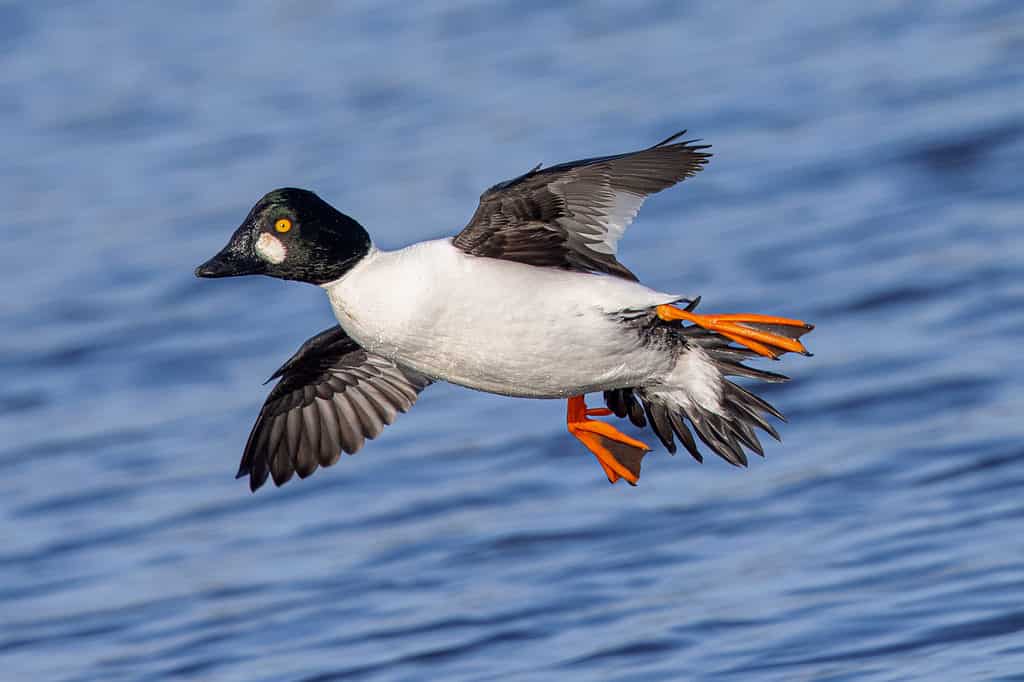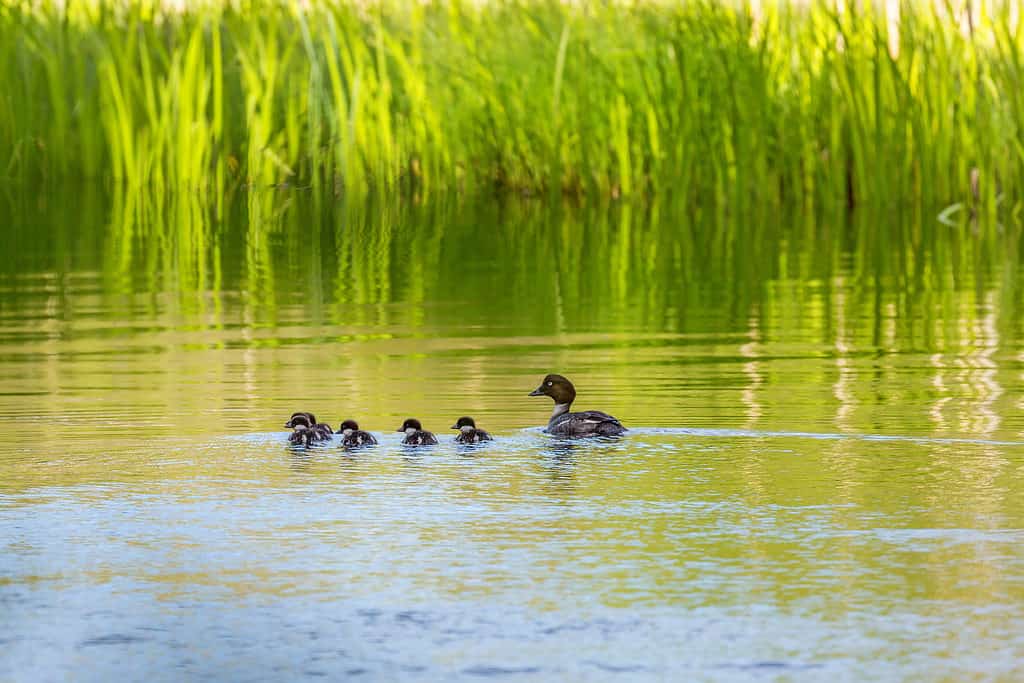Common Goldeneye
Bucephala clangula
They're known as whistlers because of the sound of the wind in their feathers.
Advertisement
Common Goldeneye Scientific Classification
- Kingdom
- Animalia
- Phylum
- Chordata
- Class
- Aves
- Order
- Anseriformes
- Family
- Anatidae
- Genus
- Bucephala
- Scientific Name
- Bucephala clangula
Read our Complete Guide to Classification of Animals.
Common Goldeneye Conservation Status
Common Goldeneye Facts
- Prey
- Invertebrates, insects, fish, eggs, plants
- Main Prey
- Aquatic animals
- Name Of Young
- Chicks
- Group Behavior
- Flock
- Breeding pair
- Fun Fact
- They're known as whistlers because of the sound of the wind in their feathers.
- Estimated Population Size
- 2.5 million
- Most Distinctive Feature
- Triangular head
- Distinctive Feature
- Bright yellow eye
- Wingspan
- 31 inches
- Habitat
- Coastal waters, lakes, rivers, and ponds
- Predators
- Foxes, birds of prey, snakes, coyotes
- Diet
- Omnivore
- Lifestyle
- Flock
- Average Clutch Size
- 8
- Nesting Location
- Cavities in trees or nesting boxes
- Migratory
- 1
View all of the Common Goldeneye images!
The common goldeneye is a species of duck native to North America. Their wings make a distinct whistling sound as the wind passes through their feathers in flight. This sound is made more noticeable in cold weather. They are a type of diving duck, which means they are able to source their food from the bottom of waterways. This species can be identified by their bright golden eyes which are present in both males and females.
Common Goldeneye Amazing Facts
- Their wings “whistle” when flying.
- Chicks leave the nest after only a day.
- During fights over territory, chicks may be swapped or end up with the wrong mother, resulting in mixed broods.
- Their eyes aren’t gold from birth; instead, they start out a gray or brown color.

Common goldeneye wings make a distinct whistling sound as the wind passes through their feathers in flight.
©iStock.com/rancho_runner
Where to Find Common Goldeneyes
The common goldeneye is only found in North America. Here, they are most likely to be seen in the United States and Canada, with only a small non-breeding region found in Mexico in the states of Chihuahua and Durango, as well as along the Gulf of California and Gulf of Mexico.
Aside from a small year-round population in Montana and Maine, the entirety of the United States population is non-breeding. This means that goldeneyes can only be found here during the fall and winter months. There is a year-round population along the United States and Canadian border, with much of northern Canada and Alaska maintaining a thriving breeding population during the spring and summer months.
Because they rely on the water for habitats and food, you will typically only see them away from water during their migration journey north or south, depending on the season. During their warmer breeding season, you can find them in the northern boreal forests. However, during their non-breeding season, they’re most common on coastal waterways and inland lakes or ponds.
Common Goldeneye Nests
Female common goldeneyes will build their nests in the cavities of living and dead trees. These cavities can be formed by various causes, from woodpeckers to broken limbs. When available, they will also use man-made nesting boxes, with a preference for boxes that are dark with wood shavings to use as nesting materials. While not the case for every individual, females will return to the same areas, and even the same nests, each year.
When it comes to building their nest, goldeneyes are quite resourceful, choosing to favor materials that are already available in their nesting location. For natural cavities, this can look like an old squirrel nest. For nesting boxes, this includes wood shavings. To insulate her nest, the female will pluck out her own down feathers and use them to line the nest.
The typical common goldeneye nest is around 8 inches in diameter. Females may lay their eggs in another female’s nest, both other goldeneye females as well as the nests of other goldeneye species. Other types of fowl may also share the common goldeneye’s nest, including wood ducks.
Common Goldeneye Scientific Name
The common goldeneye, also known commonly as just the goldeneye, has the scientific name of Bucephala clangula. The genus name is derived from the Ancient Greek word boukephalos, which translates to mean “bullheaded”. This is because the bufflehead (Bucephala albeola) is also in the genus. Its class is Aves, and it belongs to the Anatidae family.
Common Goldeneye Size, Appearance, & Behavior
Common goldeneyes display what is known as sexual dimorphism. This means that males and females look different. They grow to be 15 to 20 inches in length with a wingspan of about 31 inches, and they weigh an average of around 2 pounds as adults.
The male common goldeneye has a bright green and black head. The rest of its body, however, is black and white. Both males and females sport a bright, golden eye for which they are named. Females, however, don’t have the same bright coloration of the male common goldeneye. They have a dark brown head instead of green, and their bodies tend to favor a grey and white coloration over black and white. Whether male or female, however, the white of their wings can be seen when they’re flying.
As a member of the Bucephala genus, the goldeneye has a large head with a distinctive, round shape. They have a small, narrow bill that slopes, giving the common goldeneye a rather tiagnurla shaped profile.
Goldeneyes spend most of their time on the water. As a diving duck, they have the ability to dive several feet underwater. However, they’re also expert fliers that can reach speeds around 40 miles per hours. While they do need a running start, as all diving ducks do, they need to cover a significantly less distance than other diving ducks. In fact, they can achieve take off with only a short run of three to six feet.
These ducks live in large flocks, sometimes in groups of several hundred birds. They often dive together.

Both male and females sport a bright, golden eye for which they are named, with the male goldeneye having a green and black head.
©iStock.com/Jeff Kingma
Common Goldeneye Migration Pattern and Timing
Common goldeneyes migrate each spring and fall. During the spring and summer, they are found in their northern breeding grounds. They are considered early migrants, moving north early during the spring months. In the same manner, they also migrate back south later in the fall, meaning they spend a large amount of time in their breeding territory.
Common Goldeneye Diet
The common goldeneye is an omnivorous diving duck species. They eat aquatic invertebrates and fish as the main part of their diet. Aquatic vegetation makes up only a small portion of their diet.
Although they have the ability to dive several feet deep, common goldeneyes prefer to hunt in shallower waters. These are usually shoreline waters that are less than 13 feet deep. However, they have the ability to feed in waters more than 20 feet deep.
What does the common goldeneye eat?
The common goldeneyes have a widely diverse diet. The largest part of their diet is made up of other organisms. This includes insects, aquatic verterbrates, and fish and their eggs. They also eat seeds and tubers of aquatic plants, however.
Some of the food that common goldeneyes can be seen eating include
- Crabs
- Shrimp
- Crayfish
- Barnacles
- Mussels
- Beetles
- Insect nymphs
- Salmon
- Minnows
Common Goldeneye Predators and Threats
As a waterfowl, common goldeneyes face many of the threats that other aquatic species do. One of the main threats is lost of habitat, as well as pollution in the local waterways that they call home.
There are also many natural threats for the goldeneye, specifically different types of predators.
What eats the common goldeneye?
As eggs and chicks, common goldeneyes are at risk of being eaten by any larger animals, such as large birds, raccoons, minks, and snakes. As they get older, there is less risk of being preyed on, as fewer animals are able to eat an adult common goldeneye. Predators ofr adults include humans, large brids of prey, foxes, and coyotes.
Common Goldeneye Reproduction, Babies, and Lifespan
Males have a unique courtship display that involves several different movements. In fact, there are 14 moves in total that common goldeneye males may perform. Females who are interested in mating with the male will respond with their own move. Common goldeneyes are monogamous throughout the breeding season, up until the male leaves the female during the incubation stage. During the breeding season, common goldeneyes are highly territorial and will defend their area, chicks, and brood from other species.
Females lay around 5 to 12 eggs. Common goldeneye hatchlings will leave the nest just a single day after hatching. Their mother will stand at the base of the tree where their nest is located, calling for her young. The young chicks will jump from their nests, a fall that can be as much as 40 feet, and land safely on the ground.
After they live the nest, the goldeneye chicks will be able to find their own food. However, they do still require protection from their many predators. In many instances, the mother will stay around to protect her offspring. However, if she doesn’t, the chicks will join another common goldeneye’s brood. These mixed broods are known as creches. Creches aren’t always the result of abandonment, however. Territorial fights can also end up in mixed broods, as the young chicks will scatter while their mothers fight. When it comes time to reunite, the chicks may end up with the wrong mother.
Young goldeneyes don’t hatch with that namesake eye color. Instead, they start life with grey-brown eyes that don’t develop into that bright color until around 5 months old. They reach sexual maturity around 2 years old, and they can live to be several years old. The oldest was over 18 years old.

Goldeneyes don’t hatch with their namesake eye color, instead they start out a gray or brown turning to gold at around 5 months.
©iStock.com/TT
Common Goldeneye Population
The goldeneye is a thriving species, and has been for the past several decades. While it can be difficult to judge the exact amount of common goldeneyes due to their wide-spread distribution across North America, it is estimated that there are around 2.5 million individual birds. As a result, according to the International Union for Conservation of Nature (IUCN), they are a species of Least Concern.
View all 235 animals that start with CCommon Goldeneye FAQs (Frequently Asked Questions)
Does the common goldeneye migrate?
Yes, the common goldeneye migrates every spring and fall.
How many eggs does the common goldeneye lay?
The common goldeneye lays a single clutch each year with anywhere from 5 to 12 eggs.
How fast does the common goldeneye fly?
The common goldeneye can reach speeds up to around 40 miles per hour.
What is the common goldeneye's wingspan?
Adult common goldeneyes have a wingspan around 31 inches.
When do common goldeneyes leave the nest?
Young common goldeneyes will leave the nest the day after they hatch.
Thank you for reading! Have some feedback for us? Contact the AZ Animals editorial team.
Sources
- Mark L. Mallory, Patrick J. Weatherhead, Available here: https://academic.oup.com/condor/article-abstract/95/2/467/5189496?redirectedFrom=fulltext

















